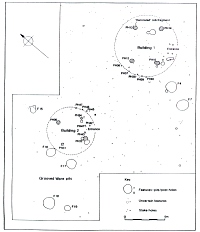|
|
|||||||||||||||||
|
Editorial Hot News from Council Change of Venue for Sheffield Prehistoric Society Day Research Meeting Mary Leakey Fordhouse Barrow Excavations 1994-1997 Chelmsford Puzzle Overseas Study Tour to the Netherlands 15-22 June 1997 Review of Fairweather Eden The Society's Visit to Bulgaria 7-14 September 1997 A Plethora of Presidents Champion's Choice Conferences and Meetings
|
|||||||||||||||||
|
A
SECOND HENGE AND NEOLITHIC BUILDINGS UNCOVERED ON WYKE DOWN, CRANBORNE
CHASE, DORSET
|
|||||||||||||||||
|
A routine flight in the summer of 1995 revealed the position
of a ring ditch only 40m to the NW of the Wyke Down henge excavated
in 1983/4 (Barrett, Bradley and Green 1991). Geophysical survey hy Steve
Burrow of Bournemouth University confirmed the new monument and also
revealed a causeway on the SE side, on a similar alignment to the entrance
causeway in the neighbouring henge. It seemed likely that this was a
second henge, perhaps aligned upon the first, and excavation began during
spring 1996. A 30m square was initially stripped to reveal the 12m diameter
monument and to include a substantial area around it. Excavation confirmed
the monument was of henge type and had been built in two major segments
- a semicircular W side and a banana-shaped E side. Where the two met
at the N end a very narrow causeway was revealed just below the level
of the surrounding natural chalk, giving a SSE axis to the monument.
Both ditch segments had been constructed by digging a series of oval
pits, the causeways for which survived to a maximum height of 56 cm
within the ditch bottom which itself was dug to a maximum depth of 1.75m.
The entirely excavated W side revealed the outlines of 10 pits, while
the E side was left Substantially unexcavated with only one trench bottomed
to reveal a single causeway. The latest silting phase within the ditch
fills produced Beaker pottery with Grooved Ware present lower down in
the secondary silts. The basal secondary silts produced both Grooved
and Peterborough wares, but not together in the same pit. The SW terminal
pit, unlike the others, had a deposit of brown soil at its base, some
20cm thick, on which an almost complete Grooved Ware pot had been placed.
This pot has a most unusual combination of decorative styles including
a possibly unique feature for Grooved Ware - an externally decorated
base. On the base of the NW terminal pit a few scraps of Peterborough
ware were found, and oil the base of another pit was a small carved
chalk hall. The asymmetric pit fills suggest the bank was on the inside
which would have allowed only a very small internal enclosed space. |
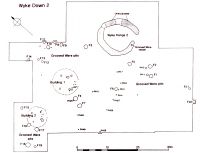 Wyke Down 2: plan of excavation |
||||||||||||||||
|
Outside
the monument to the W concentrations of pits and postholes necessitated
the expansion of the stripped area to over 2000 sq m. These features
proved to be exclusively neolithic in date with many producing sherds
of Grooved Ware. A line of 5 postholes (PH 4-6 and 26-27) runs towards
the SE henge entrance, and some 12m to the N of this line a substantial
building was discovered. This consisted of an internal 4 post rectangular
setting (PHs 12-15) some 3.25m x 4m. Placed to the SE of this setting
was a small rectangular structure about 1m x 0.75m which, together with
an elongated double posthole to the SW, appears to form an entrance
to the building. To the W lay an arc of small postholes (PHs 36-40).
A circle drawn from the centre point of the large rectangular element
on a 4m radius incorporates the surviving post arc on the W side, strongly
suggesting this is the surviving remains of the outer wall line of the
building. The overall diameter suggested by this of 8m would also incorporate
the entrance structure which bears a similar alignment as the nearby
henge. Within the surviving postpipes of the building much burnt material
was recovered, suggesting it may have burnt down. Significant finds
of daub and cob with wattle impressions included some pieces with possibly
decorative incisions on the smoothed face. A very large sherd of Grooved
Ware was found in PH 15 with smaller amounts present within most of
the other large postholes, including a sherd with concentric circles
from PH 12, suggesting formal deposition.
References:
Figures kindly provided by Wessex Archaeology
|
|||||||||||||||||
|
|
|||||||||||||||||
|
The Society has undertaken two marvellous Study Visits abroad
this year, to the Netherlands and Bulgaria, where our colleagues have
turned out in large numbers to give us the full benefit of their archaeological
knowledge, along with special access to sites and museums, and always
extremely generous hospitality. It seems a pity that only just over
1% of the membership managed to participate in each one, and so we have
given two participants plenty of space in this issue of PAST
to give the rest of us a flavour of the tours and to detail the wealth
of archaeological sites and museums visited. It also allows us to publish
some of the excellent photographs taken on the trips, which show some
of our Dutch and Bulgarian colleagues, the places they took us to, and
members of the Society in various poses! We would like to thank our
colleagues very much indeed for making the tours so interesting and
memorable.
|
|||||||||||||||||
|
HOT
NEWS FROM COUNCIL
|
|||||||||||||||||
|
1. A free student place will be available for the Society's Overseas Study Tour to central Anatolia, Turkey in the first week of September 1998. Apply to the Secretary for details, giving proof of current student membership, student status and details of reasons for wishing to participate in the tour.
|
|||||||||||||||||
|
CHANGE OF VENUE FOR SHEFFIELD PREHISTORIC SOCIETY DAY RESEARCH MEETING
|
|||||||||||||||||
|
Please note that the organisers of the Sheffield Research Meeting on Images of the Neolithic, on 24 January 1998, have announced a change of venue for the meeting to the Sir Henry Stevenson Building, Lecture Theatre 1, Mappin Street, University of Sheffield. With Professors Darvill, Whittle and Bradley, and Drs Harding, Brayshay and Hurcombe, speaking, this is an exciting programme, and they look forward to seeing many members of the Society on the day.
|
|||||||||||||||||
|
|
|||||||||||||||||
|
Mary Leakey, perhaps the world's best-known palaeolithic
archaeologist and finder of Vast African fossil hominids, died in Nairobi,
Kenya at the end of last year. Her documentation of the stone tools
from Olduvai Gorge, and the demonstration of their cultural sequence,
will stand as a testament to her academic achievements as long as people
are interested in prehistory. In the popular world she will be best
remembered by the discovery of numerous hominid fossils at Olduvai Gorge,
as well as the find of the fossil footprints at Laetoli, Tanzania, of
manlike creatures who walked upright on two legs at least 3.6 million
years ago. She was made an Honorary Member of the Prehistoric Society
in recognition of her outstanding contribution to prehistory. |
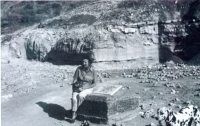 Mary Leakey on site FLKMN1 at Olduvai (©M.H. Day) |
||||||||||||||||
| Mary
Leakey was born just before the Great War, and her early childhood education
was by a governess. After the war the family travelled in Switzerland
and the south of France, where they lived for many years. As a child she
visited some excavations near Les Eyzies being conducted by Elie Peyrony,
worked with the Abbé Lemozi at Cabrerets, and developed the artistic gift
from her father by drawing stone tools as well as helping with the excavations.
Her great great great grandfather was John Frere, the first Englishman
to recognise that certain flaked flints were the work of man and were
indeed stone tools. It could be said, therefore, that archaeology was
truly in her genes. Her world collapsed when her father died suddenly,
and the family returned to London. Her interest in archaeology continued,
and at the age of 17 she was listening to lectures on archaeology, though
she never became a formal student or took a degree. In the early 1930s
she took part in digs supervised by Dorothy Liddell, and through her met
Gertrude Caton Thompson. Gertrude was a formidable figure in Middle Eastern
archaeology who was based at Oxford, and whose book, The Desert Fayoum,
Mary was asked to illustrate. This was important enough, but even more
so was the fact that it led to a meeting with Louis Leakey. As a result
Louis left his first wife and two young children in late 1934, and by
1935 Mary had joined him in Tanzania. From 1937 onwards Louis and Mary lived from hand to mouth, since the Directorship of the (Coryndon Museum was an honorary appointment. Whenever the chance arose in the dry season they went to Olduvai and collected fossils and stone tools. Of the two Mary was the meticulous painstaking excavator while Louis was restless, exuberant and intuitive. It was not until 1959 that their first important hominid find was made. This was the skull of a robust australopithecine ape-man, complete but for the jaw, and found in Bed 1, the lowest and oldest of the fossiliferous beds; it was found by Mary because Louis was in bed with influenza. This was not the last time that Mary was the one to make the big find. While Louis was alive Mary tended to take a back seat, while he revelled in the limelight, lectured world-wide and debated his finds with anyone who would listen. Mary continued her work defining the cultures and their succession from what she termed the Oldowan in Bed 1 at the bottom to the Naisiusiu at the top. She was assisted in this by Richard Hay whose dating confirmed the chronological sequence. The result of this work was a series of monographs on the archaeology of the Olduvai Gorge, Bed by Bed, that will stand for all time as a monument to her persistence, her diligence, her judgement, and her courage in undertaking this huge task and surviving to finish it. In 1972 Louis Leakey died and many wondered if this would be the end of the work at Olduvai. Not so. Work continued at the Gorge, and another site was opened nearby named Laetoli. Fossil hominids were found there that were earlier than those known from Olduvai, and even earlier than the famous "Lucy" from Ethiopia that had been attributed to a new species of ape-man, A. afarensis. It was Laetoli, however, that was the scene of Mary's triumph and the discovery in 1978 of fossilised hominid footprints in solidified volcanic ash that was more than 3.5 million years old. Their subsequent analysis showed that their form of walking was incontrovertibly human heel-toe striding. Another monograph was called for and executed. It was not all archaeology, however. She bred and judged pedigree Dalmations, she was a considerable wildlife expert in the Africa she loved, was an authority on East African rock art, and a devotee of detective fiction with a weakness for Miss Marple, a character she resembled in more ways than one. In camp, the courtesies of an English drawing room were adapted but still applied. A visit to the camp at Olduvai was a privilege, and always provided outstanding memories to all who were lucky enough to be asked and who took part in the work of her excavations.
|
|||||||||||||||||
|
FORDHOUSE
BARROW EXCAVATIONS 1994-1997
|
|||||||||||||||||
|
The Fordhouse Barrow is a Scheduled Ancient Monument
situated on the northern edge of the National Trust for Scotland's property
at House of Dun, near Montrose, Angus, on the Fast coast of Scotland,
an important area of arable agriculture. The barrow, NGR NO 6658 6053,
54m OD, was excavated between 1994 and 1997 and a complex series of
events from the early Neolithic period to the 19th century was uncovered.
Post excavation analyses are only just starting, but it is already clear
that Fordhouse is an important bench-mark site. |
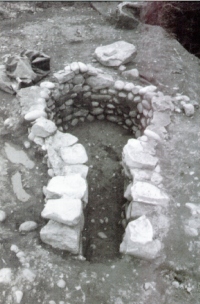 Fordhouse passage grave after excavation, from the west | ||||||||||||||||
|
Cutting these layers was a large pit in the centre of the site, l.5m deep,
which contained the dry stone walled passage grave. The chamber of the
monument was 2m in diameter with a 2m long passage facing west. This monument
was absolutely contemporary with the earliest mound construction, which
was made up of stone, earth and burnt timber The timbers within the mound
were large, up to 2m long in places. The floor of the chamber produced
a large quantity of very small pieces of fragmentary human bone and some
flintwork, including a small scraper. After a period of use the passage
was blocked, rim fragments from an early Neolithic bowl were found in
the blocking material. During the early Bronze Age the mound was substantially remodelled to produce a ring bank made largely of earth and now with an east facing entrance. This phase of construction involved the destruction of the passage grave. The chamber was largely demolished and the interior filled with soil. The capstone, 1.2m by 1.3m by 0.45m, survived near its original position over the corbelled chamber. The collapsed layers were incorporated into the enlarged mound to form a central area around 6m across. A bank, 16m in external diameter and almost 2m high, surrounded this central area. Access to the central area was through a 3m wide gap in the bank on its east side. This enlarged bank overlay a number of pits containing early Bronze Age urned cremations. One such pit contained a multiple deposit, comprising an urn inverted over a cremation among which was a flint knife, with an accessory vessel below another, smaller, collared urn beside it. Other urns containing cremations were placed in pits around the edge of the ring bank; in one was a star shaped faience bead. On the outer edge of the north east edge of the ring bank was a small short cist containing the fragmentary remains of several individuals, among which were a flint flake and a bone pin. | |||||||||||||||||
| This cist
was sealed by the next substantial remodelling of the site, which was
also associated with early Bronze Age pottery. The ring hank was covered
with a vast quantity of rounded quartzite cobbles and boulders to give
it the appearance of a cairn, a form known elsewhere in eastern Scotland,
for example at Norrie's Law, Fife. This stone cairn preserved the east
facing alignment of its predecessor, it was partly edged on the east side
with a boulder kerb. The six urned burials associated with this phase
cluster around the site of the earlier entrance. |
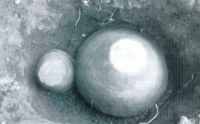 Fordhouse: cremation urns beneath the ring bank | ||||||||||||||||
|
Fordhouse Barrow has proved to be a fascinating monument in a number of
respects. It has produced a considerable quantity of stratified Neolithic
and early Bronze Age pottery, as well as other artefacts. The discovery
of the passage grave is particularly interesting and the way in which
it seems to have been slighted has many implications. Many monuments were
remodelled between a Neolithic and Bronze Age use, and Fordhouse has presented
detailed evidence for such redesigning. The passage grave itself is of
unusual construction using rounded boulders and its subterranean chamber
apparently unusual. The site shows many unique features at present, largely
because this is the first cairn to be excavated in recent times south
of the Clava Cairns, Inverness. Only when other sites have been excavated
will we be able to fit it more closely into a context. There are similarities
between the passage grave and structures at Pitnacree (Coles & Simpson
1965) and the ring bank and the site at North Mains, Strathallan (Barclay
1983), but there are differences in detail. Artefact research and detailed soil studies will be undertaken for the report . The burnt wood will be identified before samples are submitted for radiocarbon dating. The excavation has been completed and the passage grave has been refilled and covered until a decision can be made about its long-term future on the House of Dun property. The excavation was sponsored with grants and help in kind from a number of sources, including the Russell Trust, the Jennie S. Gordon Memorial Foundation, Historic Scotland and the NTS. A team of five archaeologists supervised the work, directed by Rick Peterson and managed by Edwina Proudfoot of St Andrews Heritage Services, which was carried out by an international team of NTS Thistle Camp volunteers.
|
|||||||||||||||||
|
|
|||||||||||||||||
Nicholas Wickenden from Chelmsford Museums
Service is hoping that someone may he able to identify these photographs
which they acquired as part of an auction lot, totally unprovenanced.
Please contact the Editor if you can help.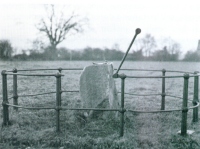
|
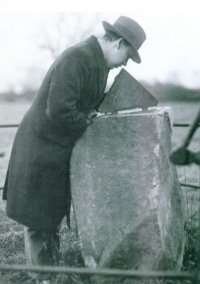
|
||||||||||||||||
|
OVERSEAS
STUDY TOUR TO THE NETHERLANDS 15-22 JUNE 1997
|
|||||||||||||||||
|
The 1997 study tour to the Netherlands, superbly organised
by Vice-President Louwe Kooijmans and supported by just over 20 members
proved an enlightening and enjoyable experience, incorporating a whistle
stop tour that covered almost every region of the country, and sampling
most of the delights that Dutch archaeology has to offer. In his usual
eloquent style, President Tim Champion neatly summarised things by pointing
out that in the space of six days the group visited 30 archaeological
sites, two University Institutes, nine museums, four media events, and
met over a dozen Dutch archaeologists. |
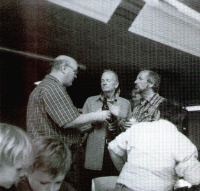 Leendert Louwe Kooijmans (r), Vice-President and tour organiser, leads serious discussions about Dutch prehistory with Presidents present and past | ||||||||||||||||
|
This was followed by a series of Linearbandkeramik sites, first Geleen-Janskamperveld,
part of the well known complex that includes Sittard, Elsoo and Stein.
For many this provided a rare opportunity to see loess in its unadulterated
state at close hand, pebble free, within which artefacts could be seen
at fifteen paces; members were noted feeling the texture, and there was
a tendency to want to take a sample home in a matchbox for comparative
purposes. Excavation at Geleen prior to redevelopment revealed a settlement
which lasted for about a century. The main interest in the new housing
estate was in front garden design, miniature landscape settings being
devised to incorporate small megaliths, and miniature water gardens incorporating
watering cans and other objects. Similarly, the LBK features at Stein now lie beneath a housing estate; however; a rather later burial chamber found above the LBK deposits has been preserved within a custom built local museum. Here we were met by local dignitaries together with representatives of the media, all of which prompted much adjustment of site worn clothes to present an air of respectability. Acting as spokesman, our President thanked them for their hospitality and expressed our interest in the site along with pleasure that it had been so well preserved in situ. There followed a reception at the new Bonnefanten Museum in Maastricht. Here both museum building and the interior is considered a work of art. The Italian influenced architecture with plain brick walls and sheets of glass is clean and well defined, with minimalist decoration, the use of space being a primary concern. Viewing too is intended to be an experience. The displays echo this, and often feature small artefacts aesthetically placed within large cases. Thus a series of refitting flakes from a Palaeolithic site at Maastricht is seen in a fresh way. Similarly, a pile of 700 (out of some 1400 recovered) apparently unused flint picks from Rijckholt, with a skull in front of them, focused attention on the relationship between the finds (whether or not they had been found in archaeological association) and created a ritual piece even if that was unintended. How this informs or educates the general public is not clean An interesting diorama depicting the dissection of a rhinoceros by a group of Palaeolithic hunters based on evidence of the bones together with traces of micro-wear on flint tools, provided contrast, but arranged after material of the Neolithic and Bronze Age periods presented a confusing chronology to the casual observer. The flat, sandy, heathland landscape of Boshoven Heath, at Weert in the southern Netherlands contains an extensive and intriguing cluster of small round barrows. Much of the area is now given over to military activity, but some 150 extant mounds remain. It is thought that there were formerly between 400-900, many of which were dug into during the 19th century, as a result of which it is estimated that some 1000 urns are likely to have been destroyed. All of the mounds are small, between 5m and 10m in diameter, most about 1m high, and surrounded by small ditches. A number were excavated to ensure that they were not dunes, and in the process some were reconstructed and partially restored. Ditches for example, were occasionally excavated to emphasize the profile. A recreational path or tourist trail meanders through the cemetery and it was strange, almost surreal, to observe a procession of pensioners cycling amongst the mounds. |
|||||||||||||||||
|
Nico Roymans conducted the group around his excavations at Weert and Someren where large areas of ground had been stripped in advance of development in order to study the development of landscape use throughout prehistoric and historic periods. At Weert the focus of activity was an Iron Age long barrow, with groups of graves, and clusters of round mounds around it. Settlement in the form of a Late Iron Age enclosure, and at a distance of 500m, five Roman buildings, lay nearby. At Someren, a further Iron Age urnfield together with about 20 farmsteads have been revealed during seven years of excavation. Discussion focused on dung and the processes involved in fertilizing sandy soil. The valuable peat encountered here only in the valleys and depressions was apparently used for fuel during the Medieval period and not for improving land. Nearby in Someren village the opportunity was taken to observe the post re-development presentation of these sites, where archaeological features were marked out not, unfortunately, on the site of the original features, but in the communal square. |
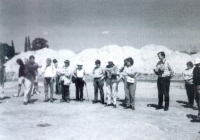 Nico Roymans (pointing) explains the Someran-Weert landscape project to Society members | ||||||||||||||||
|
Adjacent to the floodbanks of the Rhine, Jan Slofstra served up tea and cakes and described the excavations at a cemetery on alluvium at Tiel-Passeway, dating to the 1st and 2nd centuries AD. Nearby settlements had also been revealed and the aim of the current programme was to determine how these were related to each other. Archeon, an open air archaeological theme park near Leiden, with a range of reconstructions said to be based on genuine sites and set around a series of set focal points, was absorbing. In particular, a Mesolithic encampment beside a small lake incorporated several oval huts, which were spacious and warm. The opportunity was perhaps too tempting to resist and one senior British archaeologist was observed being photographed with skin clad Mesolithic-woman. However, the offer to try out the dug-out canoes was declined, a number of children having capsized. Potentially of greater interest was the LBK house inadvertently burnt down, with most charred posts still standing, and with a second house constructed adjacent to it. LBK-woman had been making pottery, and the fragility of this was demonstrated when the writer broke a pot by replacing a lid while it was warm. The herbal 'tea' from the Linearbandkeramik-style cup also took some getting used to. In the reconstructed Roman Heerlen baths the group were offered the opportunity of participating, including a massage and swim, which all surprisingly declined. Having taken a short cut to avoid the Medieval village I was threatened with the gibbet by the Vice-President. Of course the venture needs to make money, and there have already been problems in this respect. The size of the car park indicated that they received or expected large numbers of visitors. Education here is a priority and participation is encouraged in some ingenious ways. Children can help haul a large boulder using rollers, something that it would have been of interest for the group to attempt. However, a small crane was used to put capstones on the hunebed rather than taking the opportunity to experiment. The degree of controlled experiment is not clear. Many of the 'natives' were finding out empirically how to arrange furniture in long houses etc., but it was not clear if this was being recorded in any way, and one felt that the vegetables growing in the fields were for show rather than part of a prepared research design. Having stayed too long at the Archeon, it was necessary to rush through the prehistory gallery at the National Museum of Antiquities in Leiden. A pity when there were so many splendours, including wooden dolls, a neolithic fish trap, a canoe and ground axe with wooden handle from Hekelingen, a hoard of Danish axes from Nora, a Neolithic wooden wheel from Drenthe, and finds from the Hallstatt 'chieftain's' barrow at Oss. There followed a reception at the Faculty of Archaeology, Leiden. Here we were introduced to the work programmes and the individuals carrying out research as well as being given a chance to see Swifterbandt pottery and the impressive refit of Palaeolithic flint nodules from Maastricht. Most valuable. Linda Therkom described her excavations in the Assendelver Polders, where large areas were being excavated in advance of housing development. Excavations here are investigating Iron Age farmstead complexes which incorporated pits, gardens, trackways for both carts and animals, and the surrounding fields. Jurgen Bos conducted the group around his excavations at the Terp Bruggeburen, Winsum in Friesland. Here a series of massive trenches 15m by 50m were being excavated and had revealed a number of Roman and Medieval features. Many terps, essentially mounds of dung and organic debris, were often dug around the turn of the century to transplant soil to improve the soil in sandy areas; artefacts invariably got caught up in this process. There followed a wine reception at Groningen Archaeological Centre, where we were met by Professor Waterbo1k, Hon Vice-President, who had been attending a C14 conference. Groningen have always been at the forefront of C14 research. Although the visit was cut short it provided another opportunity to talk to those involved in current research. On the 'higher', sandy, ground of the Drenthe plateau is a landscape of hunebedden, 'Celtic' fields and barrow cemeteries. At Zeijen barrows were grouped around a water-filled pingo although the relationship between them and a nearby 'Celtic' field system could not be easily determined. Hunebed Ballo DXVI, part of this group, also appeared to focus on the pingo. | |||||||||||||||||
|
Nearby, at Ballooerveld, the extensive system of 'Celtic' fields is cut by a series of holloways and again has a barrow cemetery nearby, this time to the south-west. Senior members of the group considered that in one case 'Celtic' field banks appear to underlie a round barrow, an impression also observed on the published air photograph of the site (Brongers 1976, 136). In discussion it was noted that the 'Celtic' field system was arranged on a north-east axis, similar to many systems in England. Discussion centred on how the banks formed, whether they were surmounted with hedges to keep animals out/in, and the observation that no entrances appeared to be present. |
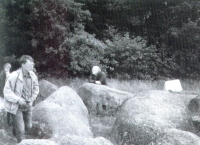 Otto Harsema (l) leads the group through a hunebed | ||||||||||||||||
|
The enormous hunebed, D27 at Barger, was well placed to allow shelter from the rain and discuss chronology, before Vice-President Kooijmans explained the intricacies of Van Giffen's Trichterbecher phasing by drawing diagrams in the sand. Here too was the impressive Hunched Museum where excellent panels and cases presented details of the local 'Celtic' fields, round barrows and megaliths, and where could be purchased such delicacies as Hunebedden cakes. Further hunebedden were visited, Drouwen D19 & D20, an adjacent pair, and at Eexe, where a small hunebed is covered by a mound, but no visit to the region would be complete without a trip to the Provincial Museum at Assen to view the superb collection of waterlogged artefacts, Neolithic wooden cartwheels, bog bodies, etc. | |||||||||||||||||
|
Then southwards, passing through the wet Swifterbant landscape (to see the ship museum at Ketelhavcn), and on to Oss-Vorstengrafdonk, the site of a barrow discovered in 1933 within which was an urn containing a cremation, together with iron knives, horse gear, and a sword inlaid with gold. Three other mounds were excavated, one of Neolithic, and two of Middle Bronze Age date suggesting that the site was long lived. The area is now destined to become an industrial estate, and as a result the whole site is to be excavated 'using the French method...trenches every 10m' over the whole area. The Prehistoric Society visit coincided with a media event to mark opening the first trench. The mayor operated the machine, while regional TV, and newspaper reporters looked on. The machine cleared trench revealed spade marks, evidently quite recent, although there was a suspicion that it may have been selected for the occasion rather than the archaeology. People trampled over the surface, stuck their umbrellas in it, while children used it as a sandpit. And then there were the Roman sites, many quite impressive. The baths at Heerlen, Maastricht Roman town, the settlement and cemetery at Tiel, settlement at Valkonburg, the terp mound at Delfland, the excavations at the Roman town of Nijmegan, as well as the Provincial Museum, Nijmegen, although here too was the impressive Iron Age cart burial from Wijchen-Wezelsche Berg. The latter visit finished this particular chapter, as well as the tour as a whole.
|
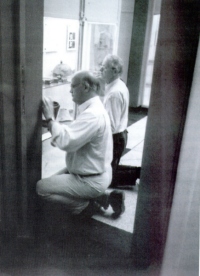 Presidents kneel in homage to Iron Age material culture in Nijmegen | ||||||||||||||||
|
Dave Field RCHME Swindon
|
|||||||||||||||||
|
REVIEW
OF FAIRWEATHER EDEN
|
|||||||||||||||||
|
This book is about the Palaeolithic site at Boxgrove and the archaeologists and specialists who have been engaged upon it. It is unlikely that any members of this Society have not heard of the site. A preliminary report was published in our Proceedings in 1986 and that on the so-called Boxgrove B project (1989-91) appears in the 1997 volume. Further work has been done since, culminating in the hominid finds and extensions in the west end of the large quarry. English Heritage are publishing a monograph on the initial work, and post-excavation studies on the vast quantity of excavated material will generate a long succession of papers. This is a site of international importance and some of the finds have already changed ideas on the status and behaviour of the resourceful humans who were on the coast of Sussex some half a million years ago. Here, with this book, is a chance to discover what has been learnt so far. Do not be misled by the chatty style of the prose. Any illusion that this is just a light-hearted account of something topical is instantly removed by scanning some pages for a few minutes. If still unconvinced, look at the bibliography.
|
|||||||||||||||||
|
THE
SOCIETY'S VISIT TO BULGARIA 7-14 SEPTEMBER 1997
|
|||||||||||||||||
|
As soon as the Society announced the visit to Bulgaria I booked; I had long been hoping that the Society could provide opportunities to visit countries such as those of the former Eastern block, where language and local conditions made individual visits daunting. 23 members took advantage of this opportunity to discover more about Bulgarian prehistory on the tour which also provided a circuit of its stunning scenery and insights into many aspects of Bulgaria today. Everyone arrived aware of the country's current economic difficulties and we were therefore especially impressed by the hospitality our hosts showed in everything from site tours to excellent food and receptions. At least 20 Bulgarian archaeologists contributed site tours, lectures, receptions and museum visits; in many cases the whole museum staff turned out en bloc to meet us. The help in understanding Bulgarian prehistory, the willing sharing of new research and the hopes expressed that the visit might be the start of more permanent connections were greatly appreciated. | |||||||||||||||||
|
The circuit of Bulgaria then began, North across the dramatic limestone Balkan Mountain range, to Temnata Dupka Cave. The karst landscape above the Iskar River was the setting for an Andante Travel 'picnic lunch' - a range of local delicacies served by our two couriers with unlimited wine. Temnata Dupka is the country's most important Palaeolithic site, with artefacts and fauna in a sequence which may start as early as 130,000 BP. Excavation of deep deposits give good stratified sequences. Tsoni Tsonev, who specialises in the Palaeolithic and lithics, gave us the first of many graphic accounts (these also included, with Bobbie, commentaries on history, scenery and aspects of modern Bulgaria). The circuit then continued West to Veliko Tarnovo, medieval capital of Bulgaria, where our hotel had excellent views of the old town and the Yantra River Gorge. Next morning Dr Petar Stanev, from Veliko Tarnovo Museum, took us to visit his excavations of an Early Neolithic settlement at Orlovec. Field work here has yielded a rich range of prehistoric sites from Neolithic to Iron Age, unknown to all of us until now; no Early Neolithic sites were supposed to exist in this part of North Bulgaria. |
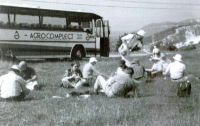 The Andante picnic lunch | ||||||||||||||||
|
On West through the flint bearing chalky landscape of the pre-Balkan range to Targovishte, central to an area with several completely excavated tells, among them Copper Age Poljanica and Ovcharovo. Dr Ilka Angelova showed us the innovative and imaginative displays of the rich local material in the new Historical Museum, and then took us to Poljanica itself, now under a reservoir, and gave a vivid account of the successive settlements on the tell and their enclosures; (prehistoric sites, flat or tell are generally unenclosed in Bulgaria). Targoviste was an excellent introduction to how high standards could be for museums in smaller towns, and how stimulating the research initiated by staff. The circuit finished that day at Varna (Greek Odessos) on the Black Sea. The next day took us up the Black Sea coast nearly to the Romanian border; much of this drive was across flat steppe-like landscape covered by chernozem soils which had developed in situ during the Bronze Age masking all earlier landuse. Round harrows, mostly of Thracian date, were frequent, as indeed in most areas. Our destination was Durankulak with Dr Todor Dimov of the Historical Museum, Dobritch, as guide. Excavation of the tell, on an island in a lagoon, has laid open a large area of Copper Age dry-stone structures, virtually unique in Bulgaria. Fieldwork shows the tell positioned next to a Neolithic settlement and the largest Neo-Copper Age cemetery in the Balkans. Back in Varna we visited the Archaeological Museum with Dr Alexander Minchev. The displays were dominated by the finds in gold, copper, spondylus and much more from the 1972 Copper Age cemetery. Such material makes a visual impact which no amount of reading can prepare one for - gold-painted pottery in the Copper Age! The visit was topped off by a generous wine reception. | |||||||||||||||||
|
Next day South down the Black Sea coast to Nessebur, Greek Mesambria. This World Heritage promontory town has a concentration of medieval churches; the vivid ecclesiastical Bulgarian architecture is decorated with red tile and green-glazed ceramics. Then back East destination Kazanluk. All these long drives showed us the countryside, the mixture of traditional agriculture - crops collected in horse or mule carts, with spreading fields dominated by sunflowers and frequently scattered with highly visible Thracian harrows; disused collective farms side by side with traditional housing. At Kazanluk is the World Heritage Thracian tomb with Greek-inspired frescoes both of warriors and an funerary banquet complete with quadriga. These frescoes are so delicate that normally only about 20 visitors are allowed in each year, but special arrangements had been made for the Society. The replica next door was an excellent copy and is generally open. Our next stay was at Stara Zagora on the edge of the Thracian plain littered with tells and tumps in the upper Maritsa valley, the locale of the outstandingly large classic tell of Karanovo. With Dr Tatiana Kuncheva we walked at ground level into trenches bordered by 12 m of stratigraphy running from Early Neolithic to Early Bronze Age. But the impact of this was as nothing to that of the tell-top covered by a whole field of vetch, barrows in the foreground and the Sredna Gora Mountains beyond. A smaller tell at Bereketska covered in brilliant blue thistles showed up the sheer size of Karanovo. Dr Petar Kulchev then took us to the Copper Age Ai Bunar mines in their forest setting in the Sredna Gora Mountains; the mines had followed a copper lode up the mountain side and excavations of substantial lengths are left open for examination of features such as fire setting. This day ended with the Copper Age burnt house preserved in situ at Zhilishte Museum, Stara Zagora, at which questions about how far the destruction of prehistoric houses may have involved deliberate activity were discussed with an example on hand. The Museum also displayed material from local prehistoric sites, a visually imaginative display which emphasized the high quality of Bulgarian pottery, especially the shapes and decoration of the Early Neolithic. Finally Director Dr Buyukliev hosted a generous reception. The final full day took us on West to Plodiv (Philopolis) and another high point of the tour. Dr Bistra Koleva showed us the finds store for the Copper Age ritual centre at Donoslav tell, excavated by Ana Raduntcheva, wall to ceiling shelves filled with complete pots and figurines which we were invited to handle. The drive into the Rhopode Mountains to Kardjali was unknown territory even to John and Tsoni. The Museum at Kardjali, in a former Muslim college, had new displays: reconstructed Copper Age house from nearby excavations, excellent reproductions of traditional interiors, and, crowning glory, in the mineral display we nearly missed, chunks of local obsidian. There is not supposed to be any obsidian source between Melos and Hungary! After all this the Conference Dinner started around 10 pm. We were treated to a surprise display of Bulgarian folk dance, mime and music. Tim Champion gave his Presidential speech at midnight, after which John sang his specially composed 'Fragmentation Ballad' about the deliberately (?) broken figurines which had been a theme for discussion throughout the tour. |
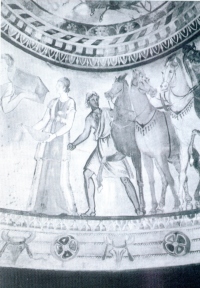 A section of the frescoes in the Kazanluk tomb replica (photography in the original tomb is not permitted for conservation reasons) 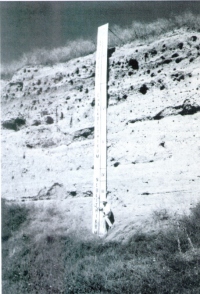 John Chapman demonstrating the depth of the section at Karanovo 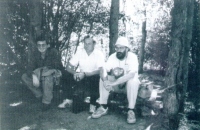 Waiting for the President: Tsoni Tsonev, Petar Kulchev and John Chapman after the visit to the copper mine at Ai Bunar | ||||||||||||||||
|
On the way to Sophia and the airport, Yunacite tell with Mrs Velichka Macanova provided the archaeological finish. At Yunacite extensive excavation shows Copper Age houses in plan. The tell is unusual because activity continued into the Bronze Age with a ditch cutting off an 'acropolis' clearly visible in section. Our final lunch at Pazhardhzik was in company with a wedding which incorporated a rich range of modern and traditional features. These varied last day activities were typical of the tour as a whole. Thank you Bulgararian colleagues, thank you Tsoni and John, for a visit we shall never forget.
|
|||||||||||||||||
|
|
|||||||||||||||||
|
Vincent Megaw sent us a copy of this photograph as a 'puzzle-picture', wondering if members could suggest on what occasion these Prehistoric Society 'greats' might have becn together in Edinburgh. He was a student of Piggott and Atkinson in Edinburgh at the time, but could not remember any major meeting of the Society there in 1954. The photograph has been published before, in Bruce Trigger's Gordon Childe: Revolutions in Archaeology (Thames & Hudson 1980, p1. 27), and is captioned 'Meeting of the Prehistoric Society in Edinburgh 1954', the photograph 'courtesy S. Piggott', and was recently used by Evzen Neustupný and Jan Turek in their tribute to Stuart Piggott in Archeologické rozhledy 49, 1997. |
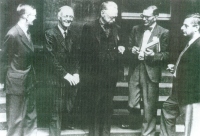 Prehistoric Society meeting, Edinburgh 1954: (l to r) Terence Powell (Vice-President), C.A. Ralegh Radford (President), V. Gordon Childe, Richard Atkinson, Stuart Piggott (Council members) | ||||||||||||||||
|
Megaw's 'puzzle' is easily solved with reference to the 50th Anniversary of the Society, and to the associated papers published in the Proceedings Vol. 51 (1985), where Bob Chapman lists on p. 17 the Regional Excursions of the Society: the 1954 excursion was to Edinburgh, Argyll and Orkney, and it must surely have been on this occasion that the photograph was taken. Despite there being a puzzle no longer, the photo is so interesting as a record of four of the Society's Presidents together (Childe 1935-6; Radford 1954-8; Piggott 1962-6; Powell 1970-74) that your Editor decided to publish it anyway!
|
|||||||||||||||||
|
CHAMPION'S
CHOICE
|
|||||||||||||||||
|
SARC-Stone Age Reference Collection: Developed as a teaching
resource, SARC is a reference program containing information about the
typology, technology, raw materials and study methods of the Stone Age,
created by Roger Grace. Material adapted from an original Hypercard
programme is enhanced by colour photographs and derails of many different
classes of stone tools; there are also research papers and a complete
on-line version of Grace's book, Interpreting the Function of Static
Tools (B.A.R. Int. Series 474, 1989)
|
|||||||||||||||||
|
|
|||||||||||||||||
|
Computer Applications in Archaeology UK Conference: 21.2.98-23.2.98
|
|||||||||||||||||
 |
The Prehistoric Society Home Page |

